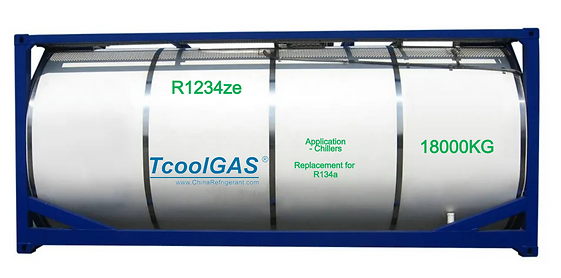Products

R1234yf
Chemical Formula: CF₃CF=CH₂
Classification: Hydrofluoroolefin (HFO), A2L (mildly flammable)
Global Warming Potential (GWP): 4 (compared to R-134a’s GWP of 1,430)
R-1234yf (HFO-1234yf) is a hydrofluoroolefin refrigerant (chemical formula CF₃CF=CH₂) classified as A2L (mildly flammable) with an ultra-low GWP of 4, making it 99% climate-friendlier than traditional refrigerants like R-134a. Its rapid atmospheric breakdown and zero ozone depletion potential align with global regulations like the EU’s MAC Directive. Primarily used in automotive air conditioning (adopted by major automakers) and commercial chillers (supermarkets, cold storage), it offers drop-in compatibility and energy efficiency. Though mildly flammable, safety measures like leak detection mitigate risks.

R513a
Chemical Formula: R-1234yf (HFO) / R-134a (HFC) (56%/44% blend)
Classification: HFO/HFC blend, A1 (non-flammable)
Global Warming Potential (GWP): 573 (compared to R-134a’s GWP of 1,430)
R-513A is a zeotropic blend of 56% HFO-1234yf (CF₃CF=CH₂) and 44% HFC-134a, classified as A1 (non-flammable) with a Global Warming Potential (GWP) of 573—60% lower than its high-GWP predecessor, R-134a (GWP 1,430). Designed as a near-drop-in replacement for R-134a, it bridges the gap between legacy HFCs and next-gen HFOs, offering industries a transitional solution to comply with phasedown regulations like the EU F-Gas Regulation and U.S. AIM Act. Primarily used in commercial refrigeration (supermarket chillers, cold storage) and industrial HVAC systems, R-513A delivers comparable performance to R-134a with minimal retrofitting, making it ideal for retrofits or new installations. Its A1 non-flammable classification simplifies handling compared to pure HFOs like R-1234yf, while its reduced GWP supports sustainability goals. Though not a long-term zero-GWP solution, R-513A’s blend balances practicality and environmental progress, serving sectors hesitant to adopt flammable alternatives.

R1234ze
Chemical Formula: CF₃CH=CHF
Classification: Hydrofluoroolefin (HFO), A2L (mildly flammable)
Global Warming Potential (GWP): 7 (compared to R-134a’s GWP of 1,430)
R-1234ze (HFO-1234ze) is a hydrofluoroolefin refrigerant with an ultra-low GWP of 7, making it 99% more climate-friendly than traditional HFCs. Its unsaturated carbon-carbon double bond ensures rapid atmospheric breakdown (~16 days) and zero ozone depletion. Classified as A2L (mildly flammable), R-1234ze is widely used in industrial heat pumps, commercial refrigeration, and foam blowing for insulation in appliances and buildings. As a key solution under the EU F-Gas Regulation, it offers high energy efficiency and near-drop-in compatibility with existing systems, minimizing retrofitting costs. Though mildly flammable, engineered safeguards like ventilation and leak detection mitigate risks. Its degradation produces trifluoroacetic acid (TFA), but environmental impact remains negligible at current usage levels.

R1233zd
Chemical Formula: CF₃CCl=CH₂ (trans-1-chloro-3,3,3-trifluoropropene)
Classification: Hydrochlorofluoroolefin (HCFO), A1 (non-flammable)
Global Warming Potential (GWP): 1 (compared to traditional foam blowing agents like HFC-245fa’s GWP of 1,030)
R-1233zd(E) is a hydrochlorofluoroolefin (HCFO) refrigerant and blowing agent with an ultra-low GWP of 1, making it 99.9% more climate-friendly than legacy hydrofluorocarbons (HFCs). Its unsaturated carbon-carbon double bond ensures rapid atmospheric breakdown (~26 days) and negligible ozone depletion potential. Classified as A1 (non-flammable), it is widely used in closed-cell foam insulation(e.g., spray foams for buildings, appliances) and high-temperature industrial chillers, offering energy efficiency and compliance with global phasedown regulations like the EU F-Gas Regulation. Unlike flammable HFOs, R-1233zd(E)’s non-flammable nature simplifies handling and installation, reducing safety risks in construction and manufacturing. Its low toxicity and compatibility with existing equipment make it a drop-in replacement for high-GWP agents like HFC-245fa. While its chlorine content raises minor environmental concerns, studies confirm minimal ozone impact and safe degradation byproducts.